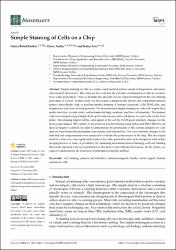| dc.contributor.author | Kosker, Fatma Betul | |
| dc.contributor.author | Aydin, Omer | |
| dc.contributor.author | Icoz, Kutay | |
| dc.date.accessioned | 2023-02-22T10:46:21Z | |
| dc.date.available | 2023-02-22T10:46:21Z | |
| dc.date.issued | 2022 | en_US |
| dc.identifier.issn | 2079-6374 | |
| dc.identifier.other | WOS:000894897000001 | |
| dc.identifier.uri | https://doi.org/10.3390/bios12111013 | |
| dc.identifier.uri | https://hdl.handle.net/20.500.12573/1450 | |
| dc.description.abstract | Simple staining of cells is a widely used method in basic medical diagnostics, education, and research laboratories. The stains are low-cost, but the extensive consumption results in excessive toxic waste generation. Thus, to decrease the amount of toxic waste resulting from the cell staining procedure is a need. In this study, we developed a magnetically driven and compartmentalized passive microfluidic chip to perform simple staining of human eukaryotic cells, K562 cells, and lymphocyte cells derived from patients. We demonstrated simple staining on cells with trypan blue, methylene blue, crystal violet, and safranin for high, medium, and low cell densities. The stained cells were imaged using a bright field optical microscope and a cell phone to count cells on the focal plane. The staining improved the color signal of the cell by 25-135-pixel intensity changes for the microscopic images. The validity of the protocol was determined using Jurkat and MDA-MB-231 cell lines as negative controls. In order to demonstrate the practicality of the system, lymphocyte cells derived from human blood samples were stained with trypan blue. The color intensity changes in the first and last compartments were analyzed to evaluate the performance of the chip. The developed method is ultra-low cost, significantly reduces the waste generated, and can be integrated with mobile imaging devices in terms of portability. By combining microfabrication technology with cell staining, this study reported a novel contribution to the field of microfluidic biosensors. In the future, we expect to demonstrate the detection of pathogens using this method. | en_US |
| dc.description.sponsorship | This research has been supported by Erciyes University Scientific Research Projects Coordination Unit under grant number FDK-2022-11974. | en_US |
| dc.language.iso | eng | en_US |
| dc.publisher | MDPI | en_US |
| dc.relation.isversionof | 10.3390/bios12111013 | en_US |
| dc.rights | info:eu-repo/semantics/openAccess | en_US |
| dc.subject | cell staining | en_US |
| dc.subject | passive microfluidics | en_US |
| dc.subject | immunomagnetic beads | en_US |
| dc.subject | colour signal | en_US |
| dc.subject | human eukaryotic cells | en_US |
| dc.title | Simple Staining of Cells on a Chip | en_US |
| dc.type | article | en_US |
| dc.contributor.department | AGÜ, Mühendislik Fakültesi, Elektrik - Elektronik Mühendisliği Bölümü | en_US |
| dc.contributor.authorID | 0000-0002-0947-6166 | en_US |
| dc.contributor.institutionauthor | İçöz, Kutay | |
| dc.identifier.volume | 12 | en_US |
| dc.identifier.issue | 11 | en_US |
| dc.identifier.startpage | 1 | en_US |
| dc.identifier.endpage | 14 | en_US |
| dc.relation.journal | BIOSENSORS-BASEL | en_US |
| dc.relation.publicationcategory | Makale - Uluslararası Hakemli Dergi - Kurum Öğretim Elemanı | en_US |


















